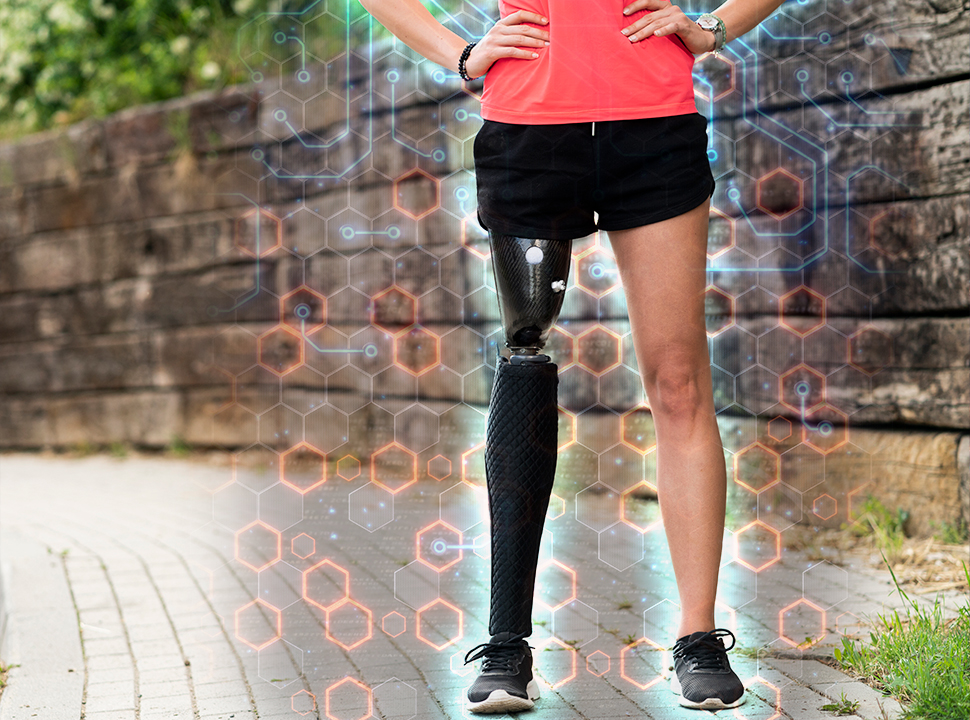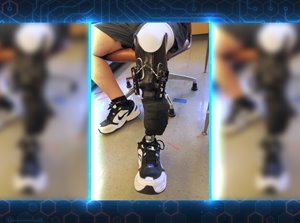Auto-Adjusting Prosthetic Socket Makes Life Easier for Amputees
Auto-Adjusting Prosthetic Socket Makes Life Easier for Amputees


A bioengineering professor is making life better for those with limb amputations by creating a prosthetic socket that automatically adapts to volume changes in residual limbs.
Many people with limb amputation struggle with managing the fit and function of their prosthesis throughout the day. Maintaining a secure and comfortable fit are often challenging because natural volume changes in the residual limb typically require the user to take time out to adjust the fit by adding or removing padding. By the end of the day the residual limb may be quite sore and irritated due to an uncomfortable or unstable fit.
Determined to improve this situation, Joan Sanders, professor of bioengineering at the University of Washington, set out to create a prosthetic socket that automatically changes size as the user’s limb size changes.
The idea came to her several years ago when she learned of a new inductive sensing chip. “We had been trying to implement a different modality for limb-socket distance sensing for about two years,” she said. “We thought the new sensing chip and antenna could be used to monitor socket thickness. We later realized that it could be used to detect socket fit.”
You Might Also Like: Advances in Prosthetics Create Realistic Motion and Touch
When funding became available through the Department of Defense, Sanders suddenly had the opportunity to make a major advance in prosthetics technology. “A quantum leap. They wanted us to think big. The idea of an auto-adaptable socket, which seemed almost absurd at the time to develop within a four-to-five-year time frame, met the criteria,” she said.
Sensors, wireless electronics, and motor-driven panels built into the socket work together to expand or tighten the socket’s fit. The auto-adjustments to the prosthetic are small, frequent, and even undetectable to users, maintaining their preferred fit to within a fraction of a millimeter during cycles of walking and sitting.
The biggest challenge, Sanders noted, was designing something small, compact, and lightweight without much previous research to draw on regarding other experimental devices for this application, or insights into the engineering needs.
Related Content: Three Advances in Prosthetics
“Debugging surrounding the ferrous liner was another challenge,” said Sanders. “It was hard because the liner is a chemical-electrical-mechanical system. It involved multiple disciplines to create. We also developed a manufacturable means for antenna installation into the prosthetic socket.”
Other key elements in the design process were:
Dive A Little Deeper: The Robot Will See You Now
Research participants who tested the self-adjusting socket reported that the new hands-free adaptive socket solved their biggest challenges. “I don’t have to think about my socket” was a common response that was the best compliment Sanders could have possibly received.
Mark Crawford is a science and technology writer in Corrales, N.M.
Determined to improve this situation, Joan Sanders, professor of bioengineering at the University of Washington, set out to create a prosthetic socket that automatically changes size as the user’s limb size changes.
The idea came to her several years ago when she learned of a new inductive sensing chip. “We had been trying to implement a different modality for limb-socket distance sensing for about two years,” she said. “We thought the new sensing chip and antenna could be used to monitor socket thickness. We later realized that it could be used to detect socket fit.”
You Might Also Like: Advances in Prosthetics Create Realistic Motion and Touch
When funding became available through the Department of Defense, Sanders suddenly had the opportunity to make a major advance in prosthetics technology. “A quantum leap. They wanted us to think big. The idea of an auto-adaptable socket, which seemed almost absurd at the time to develop within a four-to-five-year time frame, met the criteria,” she said.
Sanders assembled a cross-disciplinary team of rehabilitation medicine specialists, a chemist, and mechanical designers and engineers to create a socket that senses limb-socket distance and continually adjusts socket size to maintain a consistent distance and consistent socket fit.
“This project was a home run from the start,” Sanders said. “Our first prototype worked very well, and the innovations kept on coming to make it better, smarter, and faster. Much of the credit goes to the prosthesis user participants who spent countless hours testing our technology and providing feedback. They are the stars of this effort.”Sensors, wireless electronics, and motor-driven panels built into the socket work together to expand or tighten the socket’s fit. The auto-adjustments to the prosthetic are small, frequent, and even undetectable to users, maintaining their preferred fit to within a fraction of a millimeter during cycles of walking and sitting.
The biggest challenge, Sanders noted, was designing something small, compact, and lightweight without much previous research to draw on regarding other experimental devices for this application, or insights into the engineering needs.
Related Content: Three Advances in Prosthetics
“Debugging surrounding the ferrous liner was another challenge,” said Sanders. “It was hard because the liner is a chemical-electrical-mechanical system. It involved multiple disciplines to create. We also developed a manufacturable means for antenna installation into the prosthetic socket.”
Other key elements in the design process were:
- Actuator design. A key achievement was making a design that maintained a consistent socket shape each time a certain socket size setting was selected. Putting in an axis of rotation for the panel in the horizontal (transverse) plane was important and helped accomplish this objective. Ensuring the actuator did not protrude too far outwardly from the socket was also important.
- Control system design. Team member and Mechanical Engineering Professor Joe Garbini, a very experienced control system designer and innovator, took a step-wise systematic approach to the combined challenge of control system design and actuator design. “In hindsight, the wisdom of those steps meant that we focused on one major issue at a time, and that kept us from getting confused and going off track,” said Sanders.
- Clinical input. Research prosthetist Kate Allyn and physiatrist Janna Friedly kept the team focused on the most important clinical challenges while still helping the team accomplish the project engineering objectives. “Prosthetics is full of knowledge gained from clinical experience, and Kate and Janna’s skills at untangling complex clinical issues and explaining them to a group of engineers were essential for success,” said Sanders.
Dive A Little Deeper: The Robot Will See You Now
Research participants who tested the self-adjusting socket reported that the new hands-free adaptive socket solved their biggest challenges. “I don’t have to think about my socket” was a common response that was the best compliment Sanders could have possibly received.
The National Institutes of Health have funded an extension of Sander’s work, which is now focused on making the system smaller, lighter, and smarter, so the auto-adaptation can occur during other activities and postures.
Mark Crawford is a science and technology writer in Corrales, N.M.






